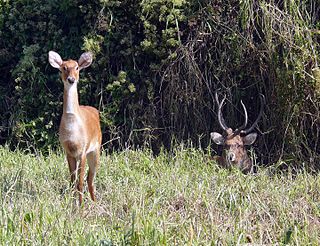Related Research Articles
The Hmar language(Northern Mizo) belongs to the Mizo language branch of the Sino-Tibetan family of languages. The speakers of this language use Mizo language as their second language (L2).

The Tangkhul people, also known as the Tangkhul , are a Tibeto-Burmese ethnic group living in the Indo–Mayanmar border area, occupying the Ukhrul district and Kamjong district in the Northeast Indian state of Manipur, and in parts of neighbouring Myanmar. Despite this international border, many Tangkhul have continued to regard themselves as "one nation". The name "Tangkhul" is originated from the Meitei language words, "Tang" meaning "scarce" and "Khul" meaning "village" respectively. According to another theory of origin, the term "Tangkhul" is derived from "Thankhul", meaning "Than village" in Meitei language.

Tangkhul is a Sino-Tibetan language of the Tangkhulic branch, spoken in different villages of Ukhrul district, Manipur, India. The term "Tangkhul" is derived from the Meitei language terms, tāng and khūl . According to another theory, the term "Tangkhul" is derived from "Thankhul", meaning "Than village" in Meitei language.
Hiyangthang is a town in Indian state of Manipur. It is best known for the Hiyangthang Lairembi Temple, a Meitei shrine dedicated to ancient Meitei goddess Irai Leima. It is located in Imphal West district.
The Hiyangthang Lairembi Temple is an ancient temple of Goddess Hiyangthang Lairembi of Meitei religion (Sanamahism). The sacred building is situated on the hilltop of Heibok Ching in the Hiyangthang, Manipur. Thousands of devotees thronged at the holy site during the festival time of Lai Haraoba of Sanamahism as well as Durga Puja of Hinduism.

The Manipur State Museum is an institution displaying a collection of artistic, cultural, historical and scientific artefacts and relics in Imphal, Manipur, India. It has galleries housing materials of natural history, ethnology and archeology.

Manipur Zoological Garden is a zoo in Iroisemba, Manipur. It is the second habitat of Sangai, the world's only dancing deer species, after the Keibul Lamjao National Park, the world's only floating national park. It is a medium sized zoological garden. It houses Schedule 1 species of amphibians, birds, mammals and reptiles. The animals kept in the zoo are mostly endemic to Manipur. The Central Zoo Authority of India recognized it as the coordinating zoo for the conservation breeding center of Sangai and Serow.

The Khonghampat Orchidarium is a botanical garden in Imphal, Manipur, India. It is dedicated to the collection, cultivation, preservation and display of a wide range of 500 varieties of orchids found in Manipur. It houses some of the rarest orchids in the world. The peak blooming season of the orchid flowers is from April to July. The finest visiting season is March to April. This Orchidarium is the orchid centre of the Forest Department of Manipur.

Khoriphaba is a God in Sanamahism, the indigenous religion of Manipur. He is the son of Sky God Salailen and the Goddess Konthoujam Tampha Lairembi. He came down from heaven to earth to search for his mother and then for a bride. He is best known for wrestling with Loyalakpa in the Lai Haraoba festival. He is also a Sagol Kangjei(polo)-playing God.

Dragons play a significant role in the legendary accounts of Meitei folklore, Meitei literature, Meitei mythology and Meitei religion (Sanamahism) of Ancient Kangleipak, Medieval Kangleipak and Modern Kangleipak.
Akongjamba was a nobleman in Ancient Moirang in Meitei mythology. He was a lover of the harvest Goddess Phouoibi. According to mythology, fate did not permit the lovers to unite, so they reincarnated. The lives of the two legendary lovers were believed to be enacted by Thangjing as a part of the epic cycles of incarnations.

Khamlangba is a deity in Sanamahism, the indigenous religion of Manipur. He is the God of iron, mining, metallurgy, steel manufacturing, hunting and war. His occupation is the extraction of the iron ores and the manufacture of steel. The Khamlangba Thenlon text mentions about his skills of iron metallurgy and blacksmith in ancient Kakching kingdom.

Panam Ningthou is a God in Sanamahism, the indigenous religion of Manipur. He is the protector of crops, especially rice, from hailstorms and thunder. According to legends, He ignited the first fire with flint. He is one of the Umang Lai deities.

In Meitei mythology and Sanamahism, the indigenous religion of Manipur, Kanglā shā is a sacred guardian beast with a lion's body and a two-horned dragon's head. It is a royal symbol of the Meitei royalties . The most remarkable statues dedicated to "Kangla Sa" stand inside the Kangla.

The ancient legend of Wanglen Pungdingheiba and Sappa Chanu Silheibi is one of the tales of incarnations described in the Moirang Shayon. Moirang was an independent kingdom, but later became a province of Manipur. It concerns the tragi-comic romantic adventures of Wanglen Pungdingheiba for his ladylove Sappa Chanu Silheibi). Wanglen Pungdingheiba was a skilled craftsman known for making musical instrument pung. Lady Sappa Chanu Silheibi was a skilful weaving artisan. Both the lovers are equally noted for their talents and good looks, thereby becoming the matters of envy of many young men and women in the kingdom of Moirang.
Koiren Leima or Leinung Yuchakha Chanu or Ayangleima is the name of the consort of Thangjing, the presiding deity of Ancient Moirang, a province in Ancient Manipur. There are two goddesses, Ayangleima Ahal and Ayangleima Atonpi, who are the first and the second wives of the god respectively. Their accounts are mentioned in the Moirang Ningthourol Lambuba, the royal chronicle of Ancient Moirang.

Meidingu Ura Konthouba or Wura Konthouba was a Meetei ruler of Ningthouja dynasty of Ancient Manipur. He is the successor of Sameirang and the predecessor of Naothingkhong. In 568 AD, he issued coins for the first time in the kingdom. During his reign, the Selloi Langmai tribes attacked the Haokap hills by trespassing into Meitei territory. The Naothingkhong Phambal Kaba describes that he uprooted the Selloi-Langmai people. His daughter was married to the King of Moirang whose descendants took the surname "Ura".
Naorem is a Meetei surname. It is native to Ancient Kangleipak. People of this family mainly inhabit in Manipur, India.

Jagoi refers to the arts of dance in Meitei culture.

Pheichom is a traditional Meitei loincloth worn by men. It is mainly made of cotton or silk in gold, saffron or white. The khamen chatpa is the most popular style of pheijom. The pheijom is similar to the dhoti, worn by men elsewhere in India.
References
- ↑ Lisam, Khomdan Singh (2011). Encyclopaedia Of Manipur (3 Vol.). Gyan Publishing House. ISBN 978-81-7835-864-2.
- ↑ Session, North East India History Association (1994). Proceedings of North East India History Association. The Association.
- ↑ International Journal of Dravidian Linguistics: IJDL. Department of Linguistics, University of Kerala. 2011.
- ↑ Dutta, Madhumita (2008). Let's Know Music and Musical Instruments of India. Star Publications. ISBN 978-1-905863-29-7.
- ↑ Lisam, Khomdan Singh (2011). Encyclopaedia Of Manipur (3 Vol.). Gyan Publishing House. ISBN 978-81-7835-864-2.
- ↑ United Asia. United Asia. 1958.
- ↑ Singh, Moirangthem Kirti (1980). Religious Developments in Manipur in the 18th and 19th Centuries. Manipur State Kala Akademi.
- ↑ Devi, Jamini (2010). Cultural History of Manipur: Sija Laioibi and the Maharas. Mittal Publications. ISBN 978-81-8324-342-1.
- ↑ Singh, R. K. Jhalajit (1992). A Short History of Manipur. R.K. Jhalajit Singh.
- ↑ Bahadur, Mutua (1988). Jewelleries of Manipur. Mutua Museum.
- ↑ General, India Office of the Registrar (1962). Census of India, 1961: Manipur. Manager of Publications.
- ↑ Anvīkshā. Jadavpur University. 2004.